I have been trading cryptocurrencies for ten years, and I have been doing Bitcoin full-time for eight years. My assets are at the tens of millions level, and I withdraw more than ten from Binance every month.
One hundred thousand feels unaffected, living leisurely and freely, without scheming and intrigue, living the life I desire.
Live.
Every morning, I first send my child to school, then come back to cook breakfast. After eating, around 9:00, I turn on the computer to check yesterday's trading.
Record summaries in your trading system, look for opportunities, like an ant moving a house, small amounts of T, I usually operate on a dozen cryptocurrencies at the same time.
During the day, from 9:30 to 10:50 is generally the busiest; the afternoon is quieter with fewer T opportunities. If trading volume is low, I won't stare at the computer, taking a break for my eyes. In the afternoon, I usually run in the park or woods, then pick up my child from school, go home.
If it’s quiet, I won’t stare at the computer, taking a break for my eyes. In the afternoon, if there’s nothing, I usually run in the park or woods, then pick up my child from school, go home.
Sometimes I cook dinner myself, sometimes I order takeout. In the evening, I generally do some trades, spending more time sharing and answering questions, and writing reviews.
Market!
If transactions are thin or there is a one-sided decline and lack of operational opportunities, I will drive to a remote pond to fish. As long as there is mobile signal, it.
You can trade on Binance while fishing, very comfortable. In short, it's about being free and easy.
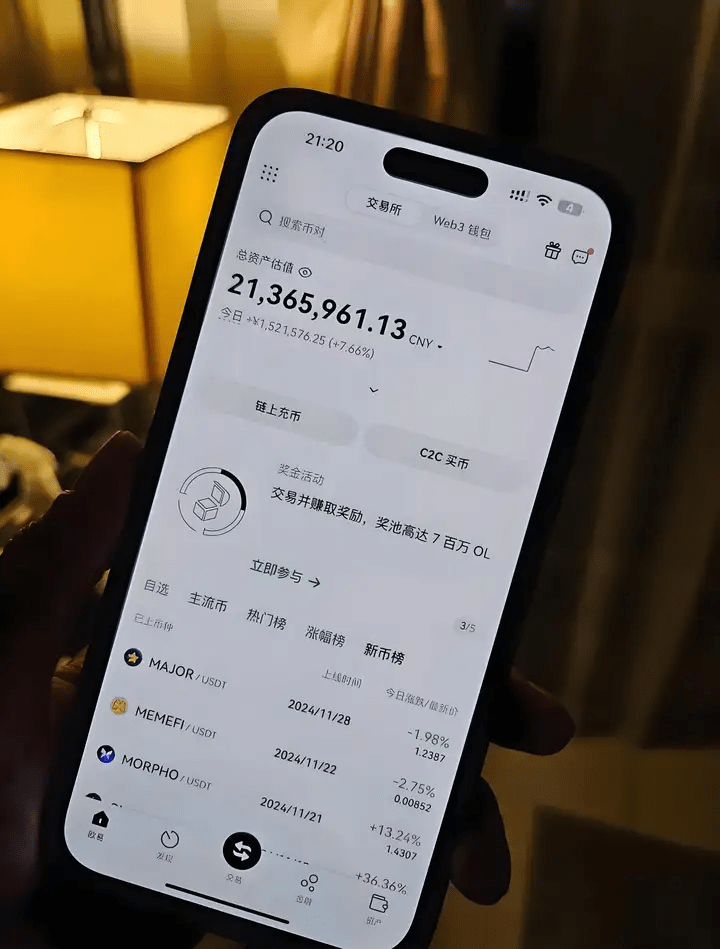
In cryptocurrency investment, maintaining account liquidity, i.e., 'having coins in the market, money in the account, and cash in the pocket', is essential for coping with market uncertainty.
A crucial guarantee of stability. Never go all in; allocate funds reasonably and master risk control. This not only stabilizes your investment mindset.
Stability can also effectively control risk. Investing with spare money instead of borrowed capital is the foundation of investing. Mastering basic operational skills and strategies.
Thinking, and developing the habit of recording and summarizing, treating the high and low data of each operation as valuable experience, gradually cultivating information screening and decision-making abilities.
Strategic capability.
In addition to solid technology, I also adhere to six strict rules: grasp the elements of successful investment!
Retail investors only need to do the following six points; turning 100,000 into 5 million is not difficult. These six points seem simple, but few can truly achieve them.
Here are the six major iron rules for winning in the cryptocurrency world, helping you navigate the market skillfully!
1. Understand stop losses and take profits. Trading cryptocurrencies is for profit, not for holding indefinitely. When positions go wrong, decisively sell to avoid.
Reveal? When making money in the cryptocurrency world, do not be greedy; when incurring losses, do not hesitate.
2. Do not pursue absolute highs and lows; the market will always have lower lows and higher highs, which ordinary people find hard to grasp accurately. We only need to be in.
Buy in the bottom area, sell in the top area, and just grasp the big trend.
3. Volume and price must perfectly match. Rising without volume or making new highs without volume often signals main force selling or exhaustion of the rise. Better to miss than.
You must pursue opportunities, avoiding becoming a bag holder.
4. React quickly. When the market shows good news, quickly find related sectors and projects. If you miss the first tier, promptly layout the second.
The second tier can also yield good returns.
5. Learn to rest. The main rising wave of cryptocurrency prices is short; most other times are spent in volatility or retracement. Capture the main rising wave, and learn to rest during other times.
Interest, avoid the loss caused by frequent trading.
6. A market crash is the biggest good news. Market crashes often give rise to greater opportunities. When others are greedy, be fearful; when others are fearful, be greedy. When the market.
During a crash, do not panic; choose quality targets and build positions in time, waiting for a rebound.
Bitcoin has skyrocketed, reviving some previous trading strategies. The simplest and most intuitive may be this so-called.
A 400-fold return in a year with the MACD trading strategy of the cryptocurrency demigod.
In fact, it is simple; it is merely about seeking opportunities for continuous MACD divergence.
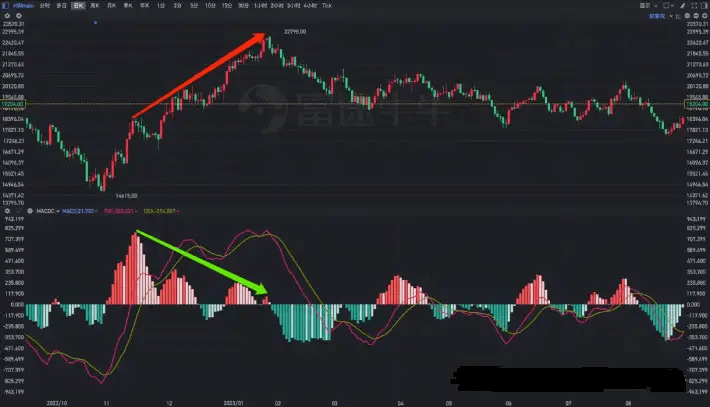
The above image is a good example, fully illustrating the two core points of this trading strategy: continuity and divergence.
What counts as continuity?
MACD is above the zero axis, after reaching a peak again without dropping below the zero axis, it goes up again creating another peak, or drops to the zero axis.
After dropping below, it quickly crossed again and a peak appeared; this is called continuity.
What counts as divergence?
MACD peaks are gradually decreasing, while stock prices are gradually increasing, indicating that the MACD trend is inconsistent with the stock price trend.
What is called divergence.
Of course, inconsistent trends can be divided into two situations: if the indicator falls while the price rises, it indicates top divergence; if the indicator rises while the price falls, it indicates.
Indicates bottom divergence.
The above image is an example of top divergence; similarly, for the Hang Seng Index, bottom divergence had already appeared before the 924 market began.
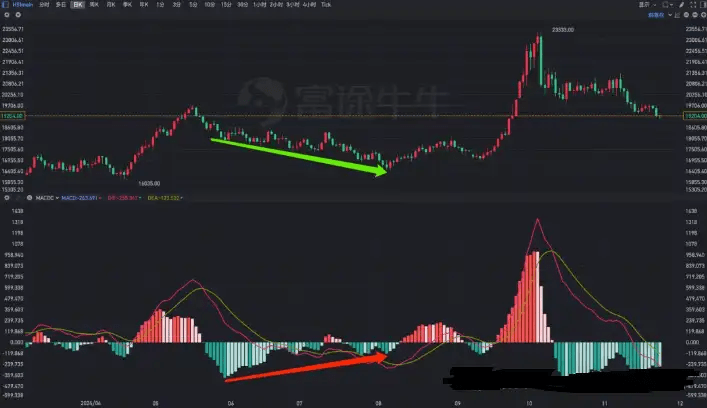
The demigod trading strategy is to seek opportunities where the MACD indicator shows continuous divergence.
First, change the default MACD parameters of 12 and 26 to 13 and 34, then look for consecutive divergences with a significant difference between peaks and troughs.
Short during divergence, go long during bottom divergence, and set stop losses based on ATR with a parameter of 13.
Causes of divergence.
From the two screenshots above, it is indeed a good opportunity to short during top divergence and to go long during bottom divergence; everyone can target their focus.
Conduct tests on targeted entities to see if this strategy can capture some significant opportunities.
During this process, you may encounter two problems: one is that the MACD indicator provided by the platform only has fast and slow lines and a bar chart, and does not add.
Of divergence recognition; thus, it is very inconvenient to verify the effectiveness of divergence signals when backtesting historical data. Secondly, backtesting data is likely to.
You will find that divergence signals are quite effective, but bottom divergence is relatively more effective than top divergence.
How to solve the problem of identifying divergence signals; we will discuss this later. For now, let's analyze the causes of divergence and why bottom divergence.
Signals are more effective.
First, let’s take a look at the code of the MACD indicator to analyze the logic behind its construction.
DIF:EMA(C,12) - EMA(C,26),COLORRED;
Indeed, the original MACD indicator is that simple; achieving the so-called 'king of technical indicators' MACD requires only three lines of code.
The first row calculates the difference between two different time period moving averages based on the closing price and displays it as a curve.
The second row calculates the average of the previous two moving averages and displays it as a curve.
The second row calculates the difference between the two and enlarges it, then displays it as a bar chart.
Even if we have not studied the design principles of the MACD indicator, we can analyze the causes of divergence based solely on its code.
If top divergence appears, meaning MACD peaks are decreasing while stock prices are increasing and making new highs, if this situation occurs.
Then it indicates that the value of MACD is decreasing.
The value of MACD is obtained by the difference between DIF and DEA, indicating that the gap between DIF and DEA is narrowing.
DEA is the average of DIF, indicating that DIF is gradually decreasing or the rate of increase is slowing down. At the same time, due to the smoothing effect of DEA.
When DIF's increase narrows, DEA is still rising, which also causes the difference between the two to narrow or even reverse.
DIF is the difference between two different period moving averages; as DIF gradually narrows or the rate of increase slows down, it actually means the difference between the two moving averages is decreasing.
Short-term moving averages are sensitive, while long-term moving averages are smooth; thus, when the difference narrows, it can be viewed as the slope of the short-term moving average beginning to approach the long-term moving average.
Slope approaches.
The slopes of short-term and long-term moving averages begin to approach, which may be due to two reasons: the stock price has fallen or the rate of increase is small, while the condition for top divergence is.
While the price continues to rise and makes new highs, the narrowing difference actually indicates that the rate of increase is diminishing, meaning a stagnation in growth.
The same derivation process shows that the cause of bottom divergence is stagnation in decline; it has stopped falling.
After a long period of volatility, once a trend forms, it is difficult to reverse. After top divergence appears, some profits may be cashed out.
However, initially, there was no confidence; only now are those who have just begun to believe gradually entering the market. Although momentum has weakened, the trend remains; after top divergence.
There is also top divergence; stock prices may form higher highs.
Similarly, after bottom divergence appears, there may also be a formation of lower lows. However, compared to rising, declines are often shorter and less severe.
After several rounds of panic release, people have become numb to negative news; there seems to be no further decline possible, at this time.
The remaining are mostly firm holders, plus the psychological advantage of buying at low levels, often triggering a strong rebound, leading to.
Bottom divergence signals are easier to realize.
Identify divergence.
If the stock price makes a new high but the indicator does not, it indicates top divergence, suggesting a weakening bullish trend and a potential market top reversal; if the stock.
If the price makes a new low but the indicator does not, it indicates bottom divergence, suggesting a weakening bearish trend and a potential market bottom reversal.
Since it is 'likely to reverse', it indicates a form of left-side trading. If trading contracts are involved, it is understandable why the demigod.
Relying on this strategy can achieve such high returns.
Of course, since it is left-side trading, there may be situations where 'there is a peak within a peak, a bottom within a bottom, and divergence after divergence,' so in demigod.
The trading strategy also specifically adds ATR-based stop losses to avoid trading contracts against the strong trend, leading to zero or even.
The risk of liquidation.
With both entry signals and stop-loss rules, logically, this is a relatively complete trading strategy. But the problem is, if you want to rely on.
Visually identifying continuous MACD divergence is likely to be very inefficient.
Although there are relevant indicators in TradingView to assist trading, domestic trading software rarely has such tools.
Indicators are mostly just flashy names, giving people the illusion that they can make consistent profits just by trading based on indicator signals.
The illusion of loss.
However, we all know that for different markets, different targets, and different times, the trading signals sent out must be treated differently.
In a strong trending market, the KDJ indicator may remain in the overbought and oversold range; in a volatile market, moving average indicators may repeatedly show golden crosses.
The cross and dead cross. If you rely entirely on a single signal, you may end up losing everything after a while.
Therefore, technical indicators should be regarded as auxiliary tools; their function should mainly focus on improving efficiency. For example.
For MACD continuous divergence, if we can achieve automatic recognition of this pattern through technical indicators, it will help us.
To better seize such opportunities.
There are three key points in recognizing divergence: trigger mechanism, time range, and judgment method. In previous articles, I taught you to implement it step by step.
We previously introduced a simple method for identifying MACD divergence.
This identification method is simple; it uses MACD's golden cross and dead cross as the trigger mechanism, using two golden crosses/dead crosses as the time range, then.
Judge whether divergence has occurred based on the trends of DIF and stock prices during golden and dead crosses.
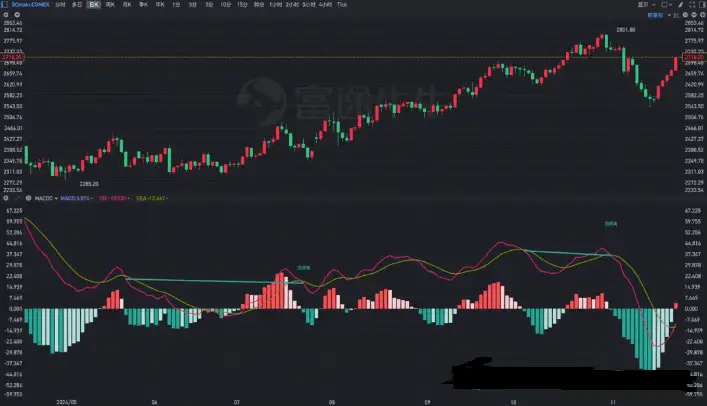
This actually belongs to a kind of speculative method; for general situations, it can still barely be used, but if you want to rely on demigod.
Using trading strategies to identify signals is clearly incorrect.
For example, continuous top divergence refers to several progressively lower peaks, and there is no retracement below the zero-axis between peaks.
After dropping to below the zero axis, there are only a few instances where it returns quickly to the golden cross.
Therefore, its trigger mechanism must first find the peak, then look back to see where the previous peak was, and whether there is a gap between the two peaks.
There are parts below the zero axis; if there are, check whether the number of bars below the zero axis exceeds the threshold, and finally judge if two peaks are ascending.
While the stock price is rising.
Similarly, continuous bottom divergence requires a trough to appear first, then look back to the previous trough to see if there is a zero-axis gap.
In this part, if there are still parts below the zero axis, check whether the number of bars below the zero axis exceeds the threshold, and finally judge whether two troughs are ascending.
While the stock price is still declining.
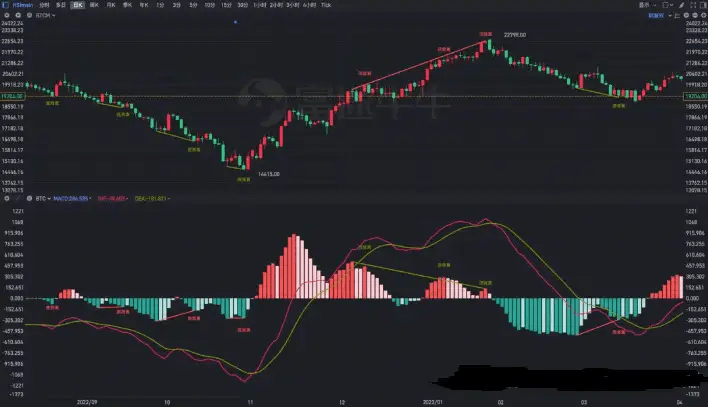
Comparing it to the screenshots given at the beginning of the article, we no longer need to draw lines manually to measure whether continuous divergence has occurred; we can use custom.
Technical indicator, identifying whether a divergence has occurred in MACD in the sub-chart and connecting peaks and troughs. In the main chart, observe the MACD wave.
Connecting the highest or lowest prices corresponding to peaks and troughs makes it easy to identify divergence.
Of course, since it is a custom indicator, the conditions for continuous divergence can be set according to one’s preferences.
For example, how many peaks and troughs need to appear continuously, whether the number of bars below the zero axis between peaks is continuous, and so on.
The difference must reach a certain level, which can be adjusted freely.
Identify trends.
Trading strategies based on divergence will enter the market before the trend is fully confirmed, exhibiting the characteristics of left-side trading, thus serving as a demigod trading strategy.
An important part of this, ATR-based stop losses are indispensable.
However, we can actually further reduce the potential risks brought by left-side trading by combining other technical indicators. MACD.
Measures the strength of the trend; for the trend itself, moving average indicators can be used for measurement.
Generally speaking, most trends are identified based on the cross of short-term and long-term moving averages. However, there is a significant problem here.
If the two time parameters are too close, the two moving averages may cross frequently, leading to a lot of ineffective signals; if the two time parameters differ too much.
If the time parameter gap is too large, the timing of entry and exit will also be severely lagged.
Therefore, we can adopt such a method: choose a time parameter you prefer and then select different moving average algorithms to obtain.
To the fast and slow lines.
For example, we first calculate MA10 using the closing price, then calculate EMA10 of MA10, thus mimicking the calculation principle of DIF and DEA.
Obtained two fast and slow lines, and then based on the crossing of these two lines to formulate buy and sell signals.
Of course, this method, compared to traditional double moving averages, only has one time parameter, but there will inevitably be a need to filter out ineffective signals.
The issue.
The market is mostly in a state of fluctuation, so we can use whether it is overbought or oversold as a filter for moving average cross signals.
For example, when the double moving average golden cross occurs, the RSI indicator value is in the 50-70 range (above 70 is considered severely overbought, do not chase high) and is rising.
It is considered an effective long signal; during the double moving average dead cross, the RSI indicator value is in the 30-50 range (below 30 is considered severely oversold, not.
If the price falls and the market is in decline, it is considered an effective short signal.
At the same time, further restrictions can be placed on K-lines, requiring that the lowest price must be above the fast line when going long, and the highest price must be below the fast line when going short.
Below the line. This allows us to achieve the effect shown in the following image.
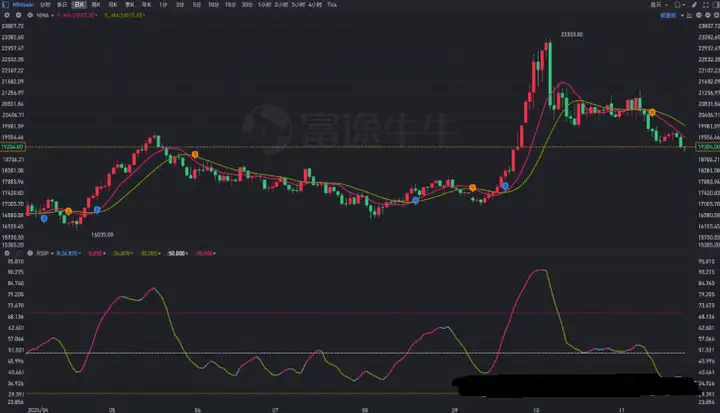
Optimization iteration.
Thus, we have constructed a trading strategy using moving averages, RSI/KDJ, and MACD, which are the most basic technical indicators.
For those who are patient enough and can trade contracts, options, and futures, pursuing a high win rate, they can wait patiently for MACD continuous divergence.
The appearance of signals. Other traders can base their short-term trades on moving average crosses + RSI filtered signals.
Moreover, at the start of a trend, it will inevitably trigger the cross of the two moving averages, while the end of a trend often forms MACD divergence.
Distance.
Therefore, combining them allows you to observe when to stop losses based on moving average cross signals, using divergence signals.
Profit; and after entering the market on the left with divergence signals, we can use moving average cross signals for right-side confirmation.
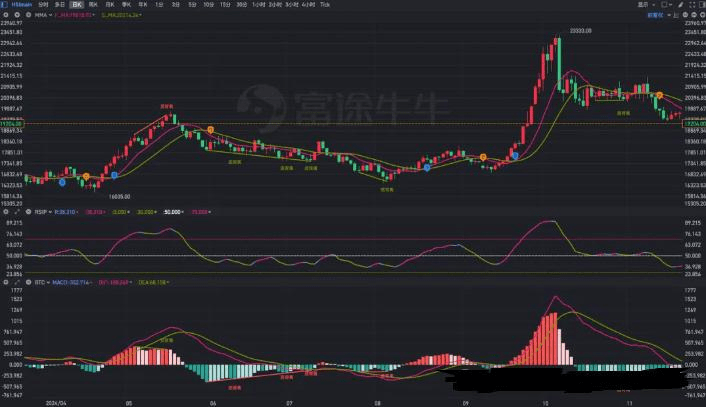
Thus, this is actually a complementary system, just differing in the priority of signals, compatibility of short-term and long-term, and historical data backtesting.
There is still great room for improvement in parameter tuning.
We welcome friends in the cryptocurrency community to provide more feedback during the use of indicators for further optimization.
The current market is just at the bottom; if you have no direction, remember to follow in my footsteps and do it, standing on the shoulders of giants.
Avoid taking ten years of detours!
I am Muqing, follow me, keep watching, and I believe you will take fewer detours! Only share the most practical cryptocurrency tips. Thank you for the likes, wishing you long-term success in the crypto world!
#美国加征关税
$XRP
